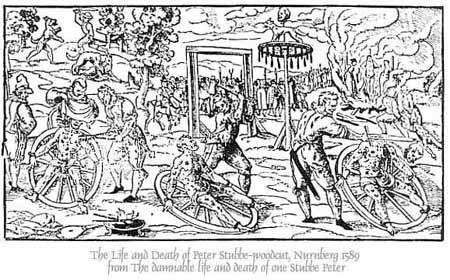The Trial of Peter Stubbe the Sorcerer

Werewolves have had many different “alignments” throughout the centuries. In the Middle Ages, they were often misunderstood or else they were healers, shamans, advisors, and guardians. So when did werewolves become evil, exactly? Whose idea was it to turn them into these insane man-beasts that eat and sometimes sexually assault people?
Fun fact: almost all of these ideas in association with werewolves can be traced back to one source. Specifically, the trial of a man named Peter Stubbe (sometimes also called Stump, Stumpp, or Stubb). This will be lengthy, as I actually based a chapter of my dissertation around this topic. But here’s the super truncated version (leaving out, for now, details of how werewolves became increasingly associated with insanity following the Middle Ages during the rise of modern science).
In 1589, Peter Stubbe was convicted of, and confessed to, numerous crimes including forcible incest with his sister, cannibalism (mostly of babies and young children), rape, murder, and various other heinous crimes. You can find a woodcut depiction of his lengthy trial and execution at the top of the post. But here’s the important detail: Stubbe was a sorcerer, not a werewolf. Werewolves in pop culture today, by and large, come from a popularized mistake made by werewolf scholars.
Since Stubbe took the form of a wolf after making his pact with the Devil (as the story goes), werewolf scholars picked up this trial and said “oh, I guess he must’ve been a werewolf, since he turns into a wolf.” This consequently became the biggest influence on modern werewolf imagery of a violent man-eating monster, as the trial gained so much traction that it left a lot of actual werewolf legends in the dust
Maybe you’re thinking, “Details! This isn’t a video game where you pick your race and class.” But even back then, these details were extremely important. Someone from the 1500s would’ve promptly corrected you if you claimed Stubbe had been a werewolf instead of a sorcerer, because the two are very different things with very different motivations. For one thing, Stubbe was meant to be in control of his actions, thus willfully committing these acts, which werewolves – in this time period – often were not, and did not commit sexual acts besides. Werewolves have, essentially, never been associated with rape (despite what The Howling movie might try to tell you).
Pick up something like the Malleus Maleficarum and you’ll find out all the reasons why it’s important to know he was a sorcerer. People catalogued the differences between things like a sorcerer and a werewolf, because they were treated and tried in different ways according to their different symptoms and acts, especially after the Catholic courts rose to power (and actually made efforts to put a stop to people burning everyone at the stake, and instead instituted sending more criminals to prisons – or secluded monasteries where they could receive mental help, and the latter is where most “werewolves” were sent and led out ordinary, peaceful lives).
True, plenty of werewolves in old legends weren’t exactly nice. But, more often than not, being a werewolf had some meaning behind it, more than just “rawr I’m a monster and I’m here to eat your babies,” ala let’s write a gore festival horror flick. Perhaps it was a test of the person’s humanity, to resist that temptation to use their monstrous form to eat human flesh (such as the Arcadians in ancient Greece) – or perhaps it was a test of the humanity of those around them, if they would take pity on someone turning into a monster and still treat them as they would any other person (similar to what happens in the medieval lai of Bisclavret)… or sometimes it was a curse put on someone but that didn’t stop them from being benevolent anyway (such as Guillaume de Palerne).
Peter Stubbe, by and large, just got mixed up in the obsession with “werewolf trials” (court trials), like the trial of Jean Grenier, a werewolf of the same time period who was accused of various crimes like cannibalism. He, however, was taken pity upon and deemed not responsible for his actions, and was sent to live the rest of his years in a monastery, where he lived peacefully for a time (but remained insane, as werewolves were associated with insanity during the late medieval and early modern period – more on that later, for sure).
Whatever the case, for better or for worse, Peter Stubbe the sorcerer mistakenly remains the most immediate source for our modern horror movie werewolves that rather simplistically go romping about in search of flesh (in every sense of the word) to sate their hunger (also in every sense of the word).